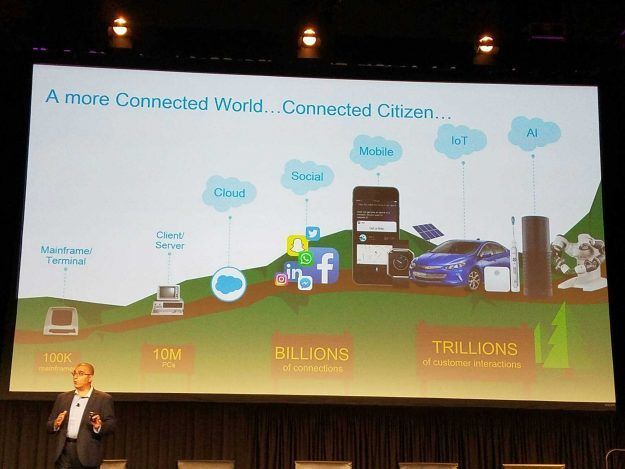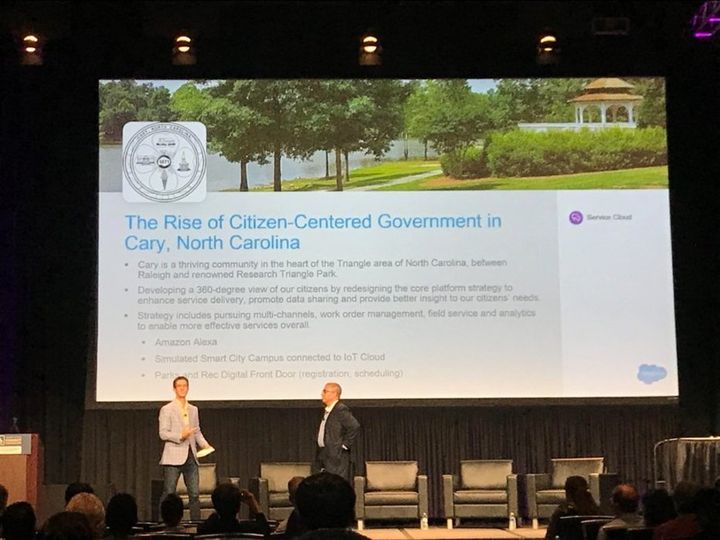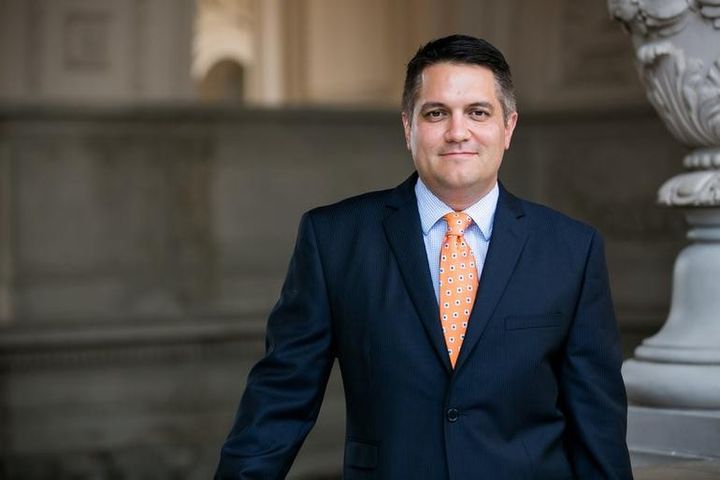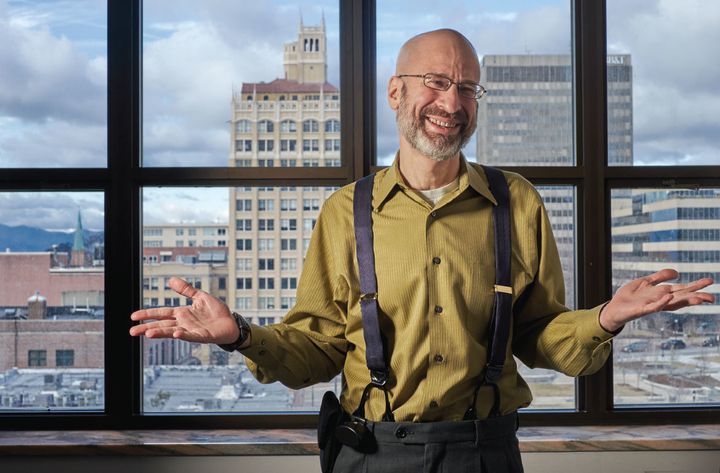I recently had the privilege to keynote at the Smart Cities Connect conference in Austin, Texas. I spoke about the disruptive combination of artificial intelligence (AI) and Internet of Things (IoT) and it positive impact towards developing a highly resilient and connected blueprint for smart cities. Powered by emerging technologies like cloud computing, mobility, social networks, IoT and AI, connected communities will expect real-time access to actionable insights that can further improve quality of life and work. In the age of connected citizens, cities must focus on the aggregation of data and agile delivery of services as they evolve their smart city operations.

The combination of cloud, mobile, social, IoT and AI will be foundational towards building a connected city
Developing a connected and smart city means understanding the disruptive nature of technology and new business models. What is important to note is that businesses and government institutions do not disrupt, people disrupt. The connected and smart city of the future is less about technology and more about design thinking with citizens at the center of every investment decision, implementation processes and adoption practices. During my keynote address, I invited Reid Serozi, innovation and analytics manager at the City of Cary to join me on stage and to share their lessons learned while implementing an omni-channel citizen engagement framework using mobile, social and AI-powered technologies, aimed at improving their citizen’s quality of life through mass personalization of service delivery at scale.

The rise of the citizen-centered government in Cary, NC - Reid Serozi, Innovation and Analytics Manager
To learn more about advance use cases of emerging technology like AI and IoT at massive scale, Ray Wang and I invited the CTO of the largest city in the United States to our weekly show DisrupTV.

Miguel Gamino, Chief Technology Officer, New York City, NY
Miguel A Gamino Jr. is the Chief Technology Officer for the City of New York under the leadership of Mayor Bill de Blasio. As CTO, he is leading major technology initiatives for the city including developing a meaningful and innovative Smart City and “Internet of Things” (IoT) strategy in collaboration with City agencies and departments; and leading the City’s Broadband Program with agencies, private industry and academia aimed at fulfilling Mayor de Blasio’s promise to provide every New Yorker and NYC business access to affordable, reliable, high-speed broadband service in all of New York by 2025. Prior to NYC, Gamino served as the City Chief Information Officer and Executive Director of the Department of Technology for the City and County of San Francisco. As an industry technologist, Mr. Gamiño participates in thought-leadership conversations with global colleagues, emphasizing the significance of pervasive broadband connectivity and the value of disrupting civic services through digital transformation. Gamino is a proud recipient of 2017 HITEC 100, 2016 State IT Executive of the Year, 2016 Top 25 Doers, Dreamers and Drivers, and Top 100 Social CIOs by HuffPost in 2015 and 2016. Gamino is a must follow on Twitter at: @MiguelGamino.
Here are the top takeaways from our conversation with Miguel Gamino:
1. The role of technology is to strengthen the community, bring more inclusiveness and create opportunities for all - Gamino was attracted to the CTO role because of the impact and value that he and him team could bring to nearly 9 million citizens of New York City. Today, New York City is the biggest city in the United States with the second largest GDP ($1.6 trillion) in the work, only behind Tokyo. The truly global scope of Gamino’s work responsibility is truly awesome in scale and complexity.
2. Scale and agility drive the technology innovation imperative - There are 1.1 million public school students in New York City; NYC public student population is greater than the entire population of San Francisco. The technology strategy for NYC means identifying capabilities that can achieve hyper scale. Gamino’s vision and technology guiding principles influences technology vendors and partners. Technology thought leaders at the highest levels from inside and outside of government are paying attention to Gamino and his team.
3. Data is an important component of the desired outcomes for connected cities - Gamino discussed the next wave of innovation with streaming data from connected things like sensors, beacons and wearable technologies. Democratizing access to data and insights is how cities can proactively deliver insights to citizens. Welcome to open data 2.0 and the future of building a more connected, resilient and smart cities.
4. Access to reliable, affordable and high-speed broadband to all of New York City residents by 2025 - No other city in the world is trying to accomplish what Gamino’s team is trying to accomplish given the conditions - political and geographical. Providing 9 million people access to affordable and reliable broadband is nearly mission impossible, but Gamino and his team, along with support from the Mayor and administration, will surely make this happen. Gamino has a strong reputation of being a visionary and doer. He is also a champion of bringing broadband access to communities for nearly two decades. The progress so far is outstanding according to Gamino and more news will be shared in the near future. Gamino reminds me of Elon Musk. In fact, Gamino jokingly noted during our show that none of us are willing to go to Mars unless there is broadband. He extended an open invite to Musk so that they can co-develop a more robust broadband strategy.
5. The Council of Global City CIOs - Gamino is a founding member of the council consisting of CIOs and CTOs of cities that are looking to develop the next generation smart and connected cities. Today, there are 10 founding cities, working on determining how to best use technology and data to develop a global strategy and a smart cities model. Gamino is an extraordinary technologist and visionary, transforming one of the most important cities in the world.
After speaking with Gamino, Ray and I followed up our conversation about smart and connect cities with another extraordinary award winning chief information officer of a city with 400,000 citizens.

Jonathan Feldman, CIO of Asheville, North Carolina
Jonathan Feldman is the Chief Information Officer for the City of Asheville, North Carolina, where his business background have helped him to create positive change in government. Asheville is a rapidly growing and popular US city based on quality of life, natural beauty, and tourism. During Feldman’s leadership, the City has been recognized nationally and internationally for improving services to citizens and reducing expenses through cutting edge digital practices and technology. Notably, the City of Asheville was the first American city in the southeast to publish an open data catalog. Feldman was named a top CIO to follow by the Huffington Post three years in a row, and was honored with Frost & Sullivan’s CIO Impact Award. You can follow Feldman on Twitter at: @_jfeldman.
Here are the top takeaways from our conversation with Jonathan Feldman:
1. You can either get on the bus, or get run over by the bus - regarding digital transformation, Feldman notes that agencies are either going to get disrupted or they will choose the right path and proactively become a more digital organization. Using cloud computing, mobile solutions (like smartphones) and social networks is how citizens expect engagement models with businesses and government agencies.
2. Decisions can no longer be made in silos - Feldman reminds business and government leaders to socialize their plans, objectives and strategy to a wider audiences using digital channels like social networks, websites, apps and digital outreach programs. City hall meetings with only 50 people will longer give your the permission and acceptance to launch major programs.
3. The opportunity to innovates starts with demonstrating operational excellence - Delivering large scale projects that involve disruptive innovation is not an option for technology leaders who fail to delivery operational excellence. Feldman believes that operational excellence is the foundation for sustainable innovation. He also believes that many startups fail because they focus too much on innovation and too little on building a reliable and available services.
4. Digital transformation is democratizing access to data, inside and outside of government agencies, while practicing radical transparency - Technology is here to create meaningful and impactful social change. Command and control does not work. Take no risk does not work. City staff must think like startups and venture capitalists, rewarding outcomes. Citizens must realize that it is not us against the government. The government is us, all of us, according to Feldman. The conversations will be data-driven and collaborative. IT is not here to do technology just for the sake of doing technology. Productive conversations will be based on data and insights.
5. Troublemakers are awesome for innovation - Feldman believes that driving positive outcomes is more about carrots and not sticks. He also references hiring trouble makers who are comfortable asking the tough questions and passionately seeking the appropriate solutions. When IT works with customers to co-create value, that’s when you can realize and accelerate digital transformation.
To expand our conversation with connected city practitioners and technology leaders, Ray and I invited Heather Clancy, editorial director for GreenBiz, to discuss several topics, including: building resilient cities with new appointments and the impact of electronic vehicles (EVs) on connected cities and large service providers. Heather is an award-winning business journalist specializing in coverage of transformative technology and in translating tech-speak into business benefits. Heather’s articles have appeared in Entrepreneur, Fortune, The International Herald Tribune and The New York Times and she is another fantastic follow on Twitter at: @greentechlady.
Our discussion with Heather started with more mayors are appointing chief resilience officers. In less than four years, the number of chief resiliency officers have grown from 4 to 80. Today, 32 cities have published their resiliency strategy.
We then shifted our focus on a collation of utility service providers investing in EV charging infrastructure, recognizing that greater adoption of EVs can lead to new business models, including new services and modes of transportation. Clancy recently noted three ways EVs could transform the ‘rules’ for urban living. She noted that there are 30 parking spots for every person that lives in Houston. As we begin to deliver more autonomous modes of transportation, with more sustainable and greener energy focused innovation, we can put people back at the center of urban development. I encourage you to watch our video conversation with Clancy - she is brilliant and masterful at explaining complex topics into very clear, concise and easy consumable stories and use cases.
The future of smart and connected cities is brighter than ever before. Trailblazers like Gamino and Feldman remind us that the best use of technology is when it can improve the quality of life.
